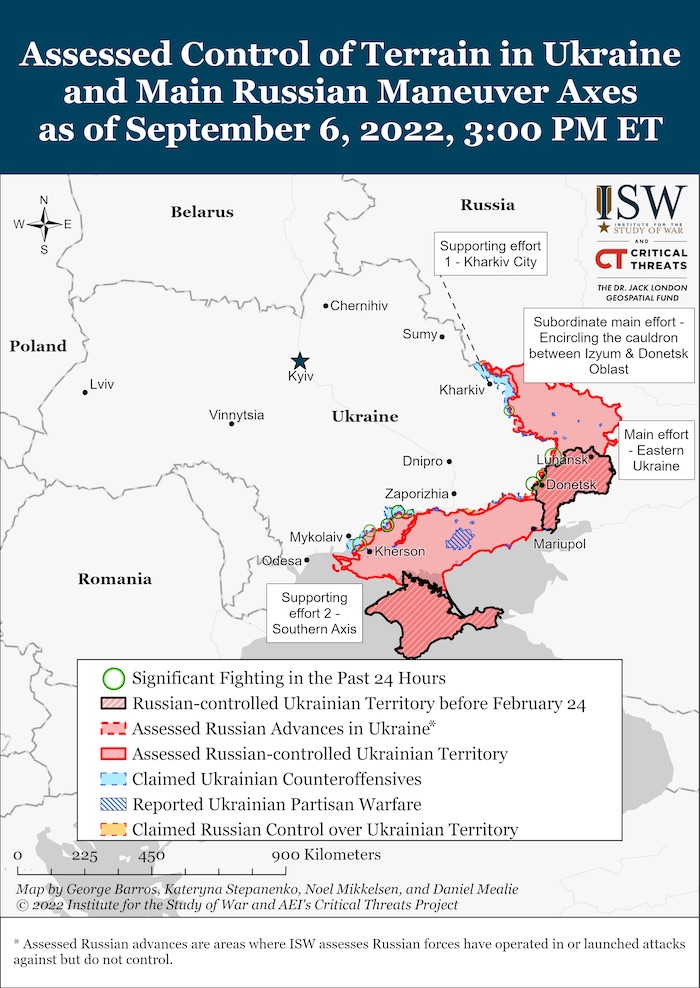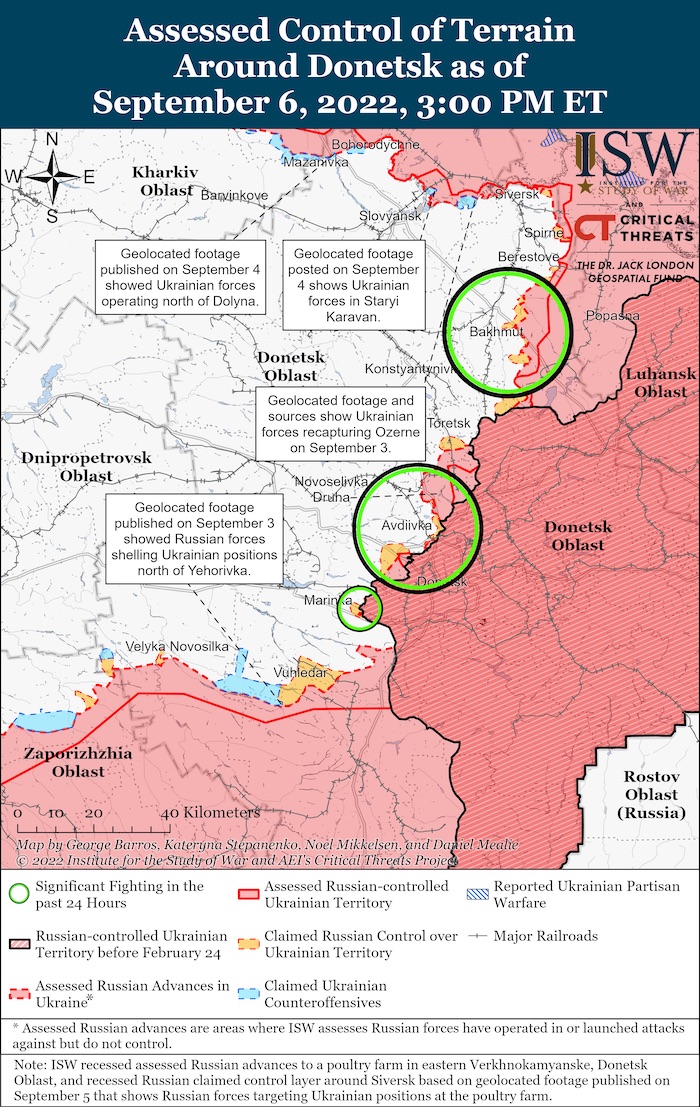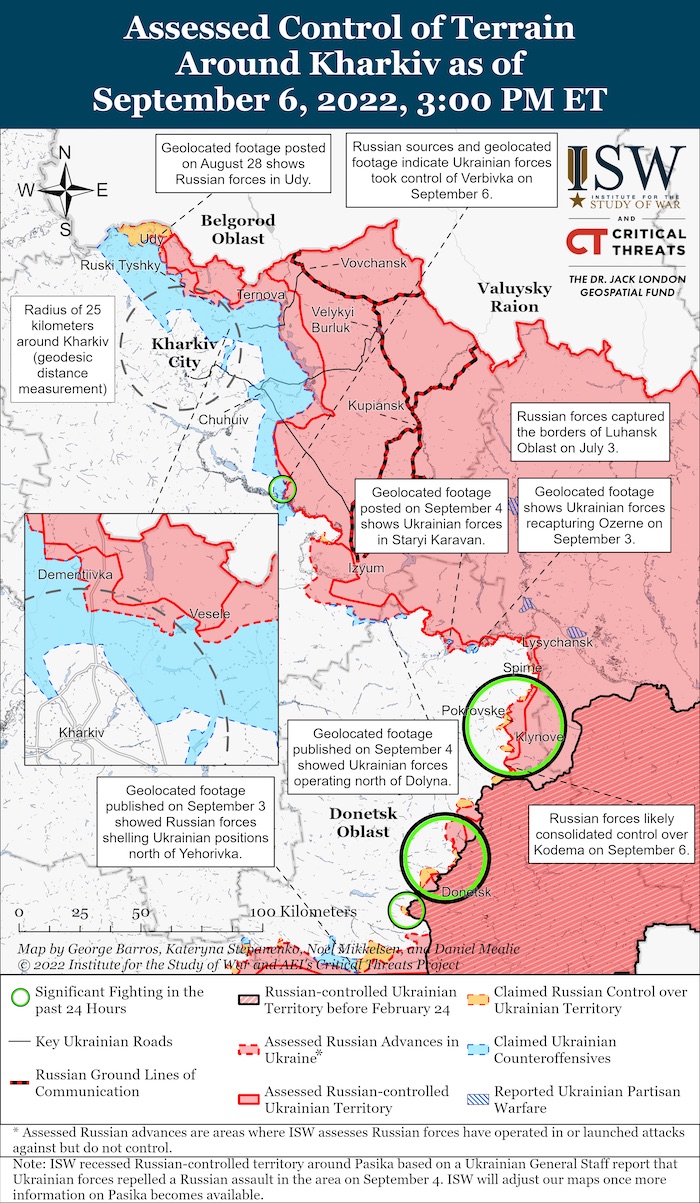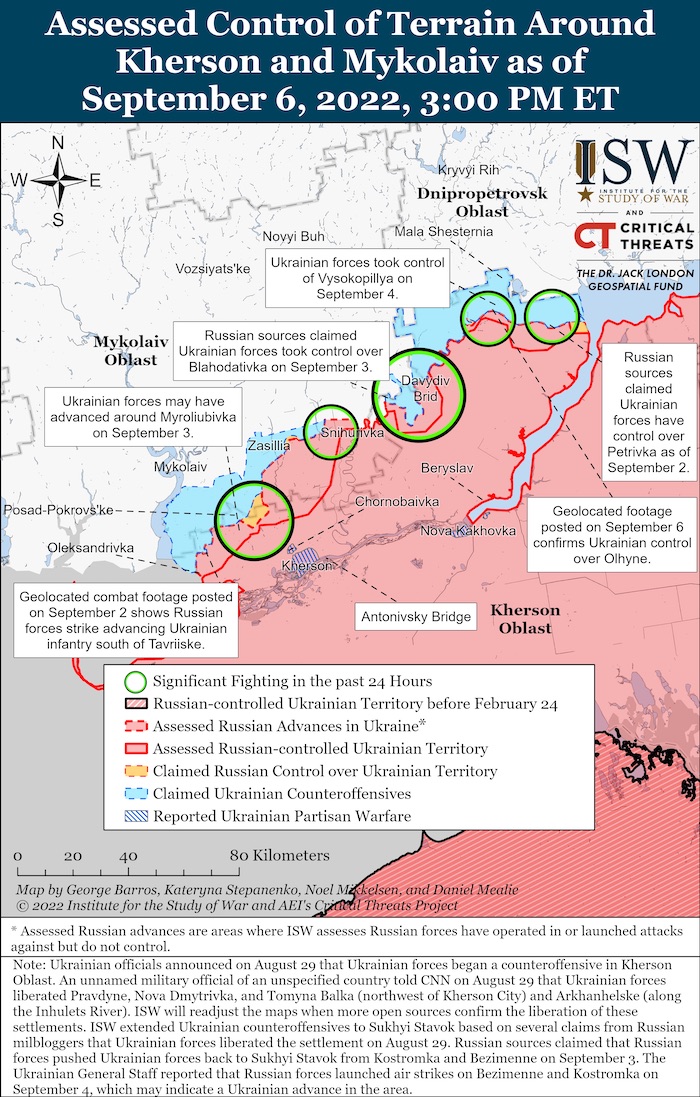Over the last 24 hours, heavy fighting has taken place on three fronts: in the north, near Kharkiv; in the east in the Donbas; and in the south in Kherson Oblast. Russia’s planned main effort is probably an advance on Bakhmut in the Donbas, but commanders face a dilemma of whether to deploy operational reserves to support this offensive, or to defend against continued Ukrainian advances in the south. A new IAEA report describes Russian activities increasing the likelihood of a nuclear accident at the Zaporizhzhia NPP while decreasing the ability of the plant’s personnel to respond to such an accident effectively. Ukrainian forces have launched counterattacks in southern Kharkiv Oblast and retaken several settlements. Russian redeployments of forces from this area to defend against the Ukrainian counteroffensive in Kherson likely prompted and facilitated these counterattacks. Ukrainian forces continue striking Russian logistics nodes, transportation assets, manpower and equipment concentrations, and control points across Kherson Oblast.
A map of the approximate situation on the ground in Ukraine as of 00:00 UTC 07/09/22. pic.twitter.com/JDaTNjTefn
— War Mapper (@War_Mapper) September 7, 2022
The General Staff’s operational update regarding the Russian invasion as of 06.00 am, September 7, 2022 is in the dropdown menu below.




Military Updates
Russia has lost 25,000 soldiers in Ukraine and has not achieved a single strategic goal, said British Defense Secretary Ben Wallace, speaking in the House of Commons. “More than 25,000 Russian soldiers died that day. If you include the dead, wounded, captured, and deserters — more than 80 thousand,” said Wallace.
The Armed Forces of Ukraine recaptured some settlements in the south. Positional battles continue, said Head of the Joint Coordinating Press Center of the Defense Forces of the South of Ukraine Natalya Humenyuk.
Russian Telegram channels started panicking about ongoing Ukrainian offensive in Balakleya that allegedly regained part of the city in the Kharkiv Oblast
However, Ukrainian officials didn't comment on the possible offensive in the Kharkiv direction so far https://t.co/ZS4KrOFexY pic.twitter.com/9xkBpywrzX
— Euromaidan Press (@EuromaidanPress) September 6, 2022
Regional Updates
In the morning today, two Russian S-300 missiles hit residential and administrative buildings in Kharkiv
There were no casualties since people had resettled but one of the buildings was severely destroyed, Oblast head said https://t.co/9kMbyL30ez https://t.co/7cgqHyX2lt pic.twitter.com/8qzWki1eK3
— Euromaidan Press (@EuromaidanPress) September 6, 2022
In the Kharkiv Oblast, the Russian army fired rockets at the city of Kharkiv once again. 1 killed in a private residential building. A residential multi-storey building was damaged.
In the Dnipropetrovsk Oblast, missile attacks hit an oil depot in Krivy Rih yet again.
According to British Defence Intelligence, (last 48 hours):
https://twitter.com/DefenceHQ/status/1567111362651766785
- Over the last 24 hours, heavy fighting has taken place on three fronts: in the north, near Kharkiv; in the east in the Donbas; and in the south in Kherson Oblast. Russia’s planned main effort is probably an advance on Bakhmut in the Donbas, but commanders face a dilemma of whether to deploy operational reserves to support this offensive, or to defend against continued Ukrainian advances in the south.
- Multiple concurrent threats spread across 500km will test Russia’s ability to coordinate operational design and reallocate resources across multiple groupings of forces.
- Earlier in the war, Russia’s failure to do this was one of the underlying reasons for the military’s poor performance.
https://twitter.com/DefenceHQ/status/1567031288388886528
Losses of the Russian army
As of Septermber 7, 2022, the approximate losses of weapons and military equipment of the Russian Armed Forces from the beginning of the war to the present day:
⚰️russia's combat losses in Ukraine as of September 7
▪ 50610 killed soldiers (+460)
▪ 4520 APV (+36)
▪ 2097 tanks (+20)
▪ 1194 artillery systems (+15)
▪ 237 aircraft (+1) and 208 helicopters (+1)
▪ 15 boats and cutters#StopRussia #StandWithUkraine pic.twitter.com/qO0DPIa1yi— VoxUkraine (@voxukraine) September 7, 2022
Humanitarian
https://twitter.com/EuromaidanPress/status/1567323012151402496
️️
Poland refused to tax Ukrainian refugees who arrived after the start of the full-scale invasion and have since been working remotely, paying income tax in Ukraine.
In August, 63,000 people were evacuated from several front-line regions, said Deputy Prime Minister Iryna Vereshchuk.
▪️Zaporizhzhia Oblast — 24,000
▪️Kherson Oblast — 18,700
▪️Kharkiv Oblast — 4,300
▪Donetsk — 16,000
The least amount of evacuees were transported from the Kharkiv Oblast. “Because it is very difficult to leave there, the corridor is open only once a week, the conditions there are difficult, so we are always so happy when we manage to save people from there. Today, we even managed to save the dogs,” said Irina Vereshchuk.
Ukraine returned the bodies of another 25 fallen soldiers, as reported by the Ministry of Reintegration. The process is conducted in accordance with the norms of the Geneva Convention.️️
Today Ukrainians in Kyiv commemorate prisoners of war who were killed in Russian-occupied Olenivka 40 days ago
"Red Cross wasn't allowed to POWs, we still don't know the precise number of killed," relatives said. Likely, there were about 50 of them. pic.twitter.com/OA2dZMZMue
— Euromaidan Press (@EuromaidanPress) September 6, 2022
Environmental
With his energy blackmail, Putin wants to ruin the stability and well-being of every household in Europe. Those who propose to give in are only inviting more trouble. Pacifying Putin by selling out Ukraine is a deal with the devil which will bring neither peace, nor stability.
— Dmytro Kuleba (@DmytroKuleba) September 6, 2022
The meeting of the UN Security Council took place in New York. UN Secretary-General António Guterres said, “As a first step, Russian and Ukrainian forces must commit not to conduct any military action in the direction of the station or from the territory of the nuclear power plant. The Zaporizhzhia facility and its environs should not be a target or a platform for military operations.” IAEA Director-General Grossi stated that he witnessed the strikes on nuclear power plants, intentional or special. He called the situation “unacceptable.”
The IAEA has published a report on the results of the mission to the Zaporizhzhia NPP.
▪️It is vital to establish a permanent IAEA presence at the station.
▪️The shelling of the Zaporizhzhia NPP can lead to damage to important equipment and the unlimited release of radioactive materials.
▪️The mission experts will carry out detailed and continuous work on the assessment of losses to the plant facilities, and check the safety and working conditions of the personnel.
▪️The IAEA has a specific and detailed technical plan for the provision of safety and security assistance. In particular, the supply of equipment to the Zaporizhzhia NPP has begun.
▪️To prevent an accident, it is necessary to take measures such as the immediate establishment of a nuclear safety zone.
Enerhodar is completely de-energized due to damage to power lines in the area of Zaporizhzhia NPP. According to the mayor of Energodar Dmytro Orlov, at 12:20 residents heard a strong explosion, after which light and water disappeared in the city.
Gazprom is intimidating Europe with threats of extreme cold: the company has published a video called “And the winter will be huge.” In the video, Gasprom shuts off gas and an “ice age” begins in Europe this winter.
How do you say "I am a gas station run by a mafia masquerading as a country" with a 2-minute video. https://t.co/8LklhLxaoM
— Christo Grozev (@christogrozev) September 7, 2022
Russia received more money from the sale of energy resources than it spent on the war with Ukraine. Spiegel journalists found that the income of the Russian Federation during the war amounted to the equivalent of 158 billion Euros, and spending on military operations is estimated at 100 billion Euros. The EU was reported to be the biggest energy buyer at 85 billion Euros (leading among countries is Germany), followed by China with 35 billion Euros.
Legal
Admission of guilt: #Russia blocks international investigation of #Olenivka mass killing of #Ukraine️ POWs who defended #Mariupol and #Azovstal#FreeAzovstalDefenders #StandWithUkraine #RussiaWarCrimes #StopRussia https://t.co/9rrsORf2jN pic.twitter.com/0tm2Hukb5d
— Halya Coynash (@halyapuff) September 7, 2022
The European Commission approved the suspension of the simplified visa regime with Russia from Monday, September 12. This means that for the Russians: The visa fee will increase to 80 Euros and they will have to wait up to 6 months for a visa. There will be no long-term and multiple entry visas or the quantity will decrease. “Schengen visas” will be issued only for the dates of the trip. Russians with a multiple-entry visa will still be able to enter the EU until their expiration date. However, the consulates of the EU countries are recommended to check applicants for Schengen visas for a threat to EU security and international relations.
#Russia wants 64-year-old #CrimeanTatar to die in prison for refusing to collaborate in occupied #Crimea #Ukraine #FreeMuratov #LetMyPeopleGo #StandWithUkraine #StopRussiahttps://t.co/tDyk4JrNOL pic.twitter.com/vSfMuj1moV
— Halya Coynash (@halyapuff) September 6, 2022
Support
Ukraine sent a request to NATO with a request to provide winter clothes and winter tents for 200 thousand soldiers. The head of the Ukrainian Defense Ministry Reznikov sent a corresponding letter to Alliance Secretary General Stoltenberg in July. NATO officials told reporters that the United States, Canada, Sweden, and Finland have already promised supplies that can cover about 50% of the requested needs. Germany is also planning to join the process. At the same time, Spiegel notes that certain difficulties can already be noted, since stocks of winter equipment in most countries are mainly reserved for national needs.
Germany refused to transfer Leopard-2 tanks to Ukraine. The Germany government reported that they did not cease to support Ukraine both in military and political, financial, and humanitarian plans. Details are not disclosed.
https://twitter.com/EuromaidanPress/status/1567302628320727042
New Developments
500 investment projects worth $400 billion listed in Advantage Ukraine platform, launched by UA Economy Ministry
"It is necessary to invest in Ukraine now, and not wait for the end of the war," UA Economy Minister Yuliya Sydorenko stressed https://t.co/0XnuVQ6gIr pic.twitter.com/zpa8AARZ4q
— Euromaidan Press (@EuromaidanPress) September 6, 2022
US President Biden refused to recognize Russia as a state sponsor of terrorism. When asked by one of the journalists at a press conference at the White House whether Russia should be recognized as a state sponsor of terrorism, he answered: “No” and refrained from further comments.
In the UK, Boris Johnson handed over the post of Prime Minister to the newly elected Liz Truss and left the residence of the head of government.
https://twitter.com/EuromaidanPress/status/1567286270006419456
Assessment
- On the war.
The Institute for the Study of War has made the following assessment as of 6 September 2022:
The International Atomic Energy Agency’s (IAEA) September 6 report on the situation at the Zaporizhzhia Nuclear Power Plant (ZNPP) described numerous ways in which Russian occupation authorities and the Russian military are jeopardizing the safe operation of the plant.[1] The report does not attempt to determine which party is responsible for the shelling that has damaged the facility and repeatedly calls on “all relevant parties” to take measures to improve the situation. The moderation and apparent neutrality of that language can overshadow the extremely clear articulation of the Russian activities undermining the plant’s safety and the fact that the report attributes no dangerous actions to Ukraine. The IAEA’s report is thus a coded condemnation of Russian moves that have created and are perpetuating the danger of nuclear disaster in Ukraine.
The report specifically notes that Ukraine reported to the IAEA that Russian forces had positioned military equipment in two turbine halls and various other facilities in and around the ZNPP.[2] It adds that the inspection team that finally visited the plant recently directly observed Russian military equipment in turbine halls and elsewhere around the plant.[3] It added that personnel from Russia’s state atomic energy organization, ROSATOM, were at the site and observed that “the presence of Rosatom senior technical staff could lead to interference with the normal lines of operational command or authority and create potential frictions when it comes to decision-making.”[4] It also noted that “the operating staff did not have unrestricted access to some areas, such as the spray cooling ponds, roofs of the buildings, and structures in the area of the water intake, and that access to the cooling ponds area was required to be granted by the military personnel at the site.”[5] The IAEA’s inspection team was told that “the on-site emergency centre was not accessible to the plant staff for emergency response as it was occupied by the military authority.” The team visited the alternative emergency center and observed that it lacked “an independent power supply or an independent ventilation system, and there is no internet connection to enable effective communication with all parties involved in an emergency response.”[6]
The IAEA report thus demonstrates that Russian officials have placed military equipment in locations inhibiting access to essential facilities, installed their own personnel to oversee the plant’s operations in ways that the IAEA judges could undermine effective response to a nuclear emergency, restricted the Ukrainian operating staff’s access to key parts of the facility, and shifted the emergency center to a location lacking essential components vital to an effective response to a serious nuclear emergency. The Russians have thus created conditions at the ZNPP that increase the risk that an emergency could occur and significantly increase the danger that the operating staff will be unable to respond efficiently and effectively in such an event.
Russian President Vladimir Putin could seek to use the fears that his actions are causing to coerce the IAEA and the international community into a de facto recognition of Russia’s right to be involved in the operation of the ZNPP, which he might seek to portray as de facto recognition of Russia’s occupation of southern Ukraine. The somewhat coded language of the IAEA report reflects the fact that Ukraine remains the operator of the ZNPP and the party responsible for its safe operation and for complying with the IAEA under international law. The IAEA cannot directly engage Russia regarding the plant’s operation without at least tacitly admitting that Russia has some right to be consulted. Putin might seek to take advantage of this situation to attempt to create a process analogous to the Minsk Accords that established the “ceasefire” in Ukraine following Russia’s 2014 invasion. The Minsk and Minsk II agreements treated Russia as a neutral party rather than a participant, thereby tacitly accepting Putin’s assertion that Ukraine was in civil war rather than the victim of Russian aggression. Putin might seek to use the conditions he has created at the ZNPP to establish a parallel international framework undermining Ukraine’s sovereign rights over the much greater expanse of Ukrainian territory Russian forces now occupy.
Ukrainian forces conducted a counterattack in Kharkiv Oblast near Balakliya that likely drove Russian forces back to the left bank (north side) of the Severskyi Donets and Serednya Balakliika rivers on September 6. Ukrainian forces likely captured Verbivka (less than 3 km northwest of Balakliya) on September 6.[7] Geolocated footage posted on September 6 shows Ukrainian infantry in eastern Verbivka (less than 3 km from Balakliya).[8] Multiple Russian sources acknowledged Ukrainian gains in Verbivka and reported that Russian forces demolished unspecified bridges in Balakliya‘s eastern environs to prevent further Ukrainian advances.[9] Images posted on September 6 also show a destroyed Russian bridge over the Serednya Balakliika River—a geographic feature behind which the Russian front line in this sector likely lies.[10] Social media users reported that Russian forces withdrew from checkpoints six kilometers west of Balaklia on September 6.[11]
Russian forces likely no longer maintain their previous positions in Bairak and Nova Husarivka (just south of Balakliya on the right bank of the Siverskyi Donets River). Russian forces likely abandoned Bayrak and Nova Husarivka in late August. Images posted on August 30 show that Russian forces blew the bridge over the Siverskyi Donetsk River near Bayrak on an unspecified date.[12] Bridge demolition activity indicates a planned Russian withdrawal. Ukraine’s General Staff reported on September 6 that Russian forces conducted air strikes against Bayrak, indicating that Ukrainian forces may have advanced in the area.[13]
Russia’s deployment of forces from Kharkiv and eastern Ukraine to Ukraine’s south is likely enabling Ukrainian counterattacks of opportunity. The September 6 Ukrainian counterattack in Kharkiv was likely an opportunistic effort enabled by the redeployment of Russian forces away from the area to reinforce Russian positions against the Ukrainian counteroffensive in Kherson Oblast. Obituary data on Russian servicemen indicates that Russia deployed elements of the 147th Artillery Regiment of the 2nd Motorized Rifle Division of the 1st Guards Tank Army to Kherson Oblast no earlier than late August.[14] This is the first time ISW has observed elements of Russia’s elite 1st Guards Tank Army operating in southern Ukraine. Elements of the 147th previously fought in Bucha in Kyiv in March and elements of the 1st Guards Tank Army were active primarily along the Kharkiv Axis after the Russian withdrawal from Kyiv.[15]
Key Takeaways
- The International Atomic Energy Agency report released on September 6 describes Russian activities that increase the likelihood of a nuclear accident at the Zaporizhzhia Nuclear Power Plant while decreasing the ability of the plant’s personnel to respond to such an accident effectively.
- Ukrainian forces have launched likely opportunistic counterattacks in southern Kharkiv Oblast and retaken several settlements. Russian redeployments of forces from this area to defend against the Ukrainian counteroffensive in Kherson likely prompted and facilitated these counterattacks.
- Ukrainian forces are continuing an operational-level interdiction campaign and striking Russian logistics nodes, transportation assets, manpower and equipment concentrations, and control points across Kherson Oblast.
- Russian and Ukrainian sources discussed kinetic activity northwest of Kherson City and in western Kherson Oblast along the Inhulets River.
- Russian forces made incremental gains south of Bakhmut and continued ground attacks north, northwest, and southwest of Donetsk City.
- Russian authorities continue setting conditions to Russify Ukrainians living in Russian-occupied Ukrainian territory.








